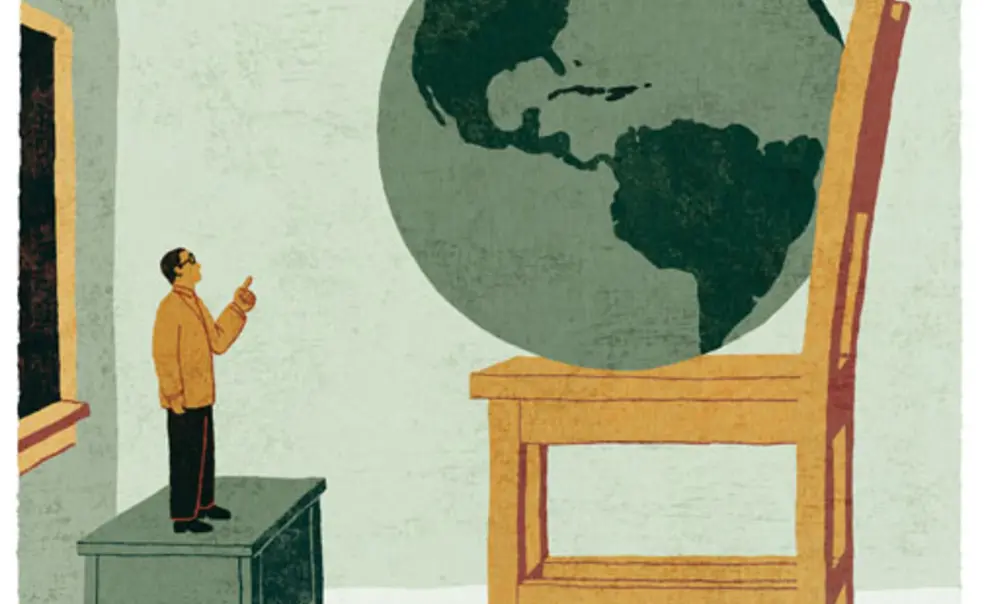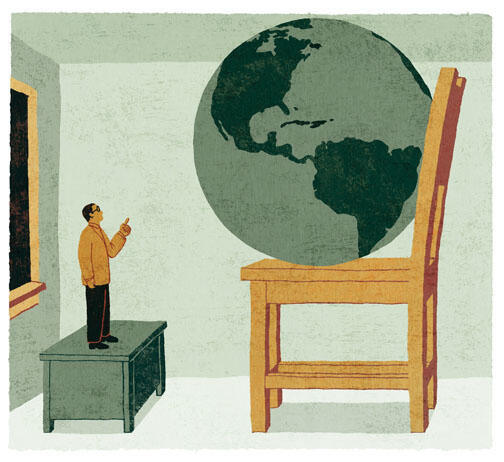The world is his classroom
A few months ago, just as the Princeton campus had grown nearly silent after Commencement, 40,000 students from 113 countries arrived here via the Internet to take a free course in introductory sociology. The noncredit offering came about through a collaboration among Coursera, a new venture in online learning, and 16 universities, including Princeton.
When my class was announced last spring, I was both excited and nervous. Unlike computer science and other subjects in which the answers are pretty much the same around the globe, sociology can be very different depending on the country that you come from. As letters and email messages began arriving in anticipation of my course, I wondered how I, an American professor, could relate my subject to people I didn’t know from so many different societies.
Would my lectures become yet another example of American ethnocentrism and imperialism as I presented my sociological concepts like so many measuring sticks for the experiences of others around the world? Was it really possible, I asked myself, to provide quality education to tens of thousands of students in more than 100 countries at the same time? And could I do it in a way that would respond to the diversity of viewpoints represented from six continents?
My concerns grew deeper as I sat before the cold eye of the camera to record my first lecture. With nobody to ask me a question, give me bored looks, or laugh at my jokes, I had no clues as to how the students might be responding. Staring into this void, it was hard for me to imagine that anyone was listening. Can we even call these “lectures” when there is no audience within the speaker’s view? Aren’t those interpersonal cues — those knowing nods and furrowed brows — that go from the audience to the professor as crucial to the definition of a lecture as the cues that go from the lecturer to the audience?
My opening discussion of C. Wright Mills’ 1959 classic book, The Sociological Imagination, was a close reading of the text, in which I reviewed a key chapter line by line. I asked students to follow along in their own copies, as I do in the lecture hall. When I give this lecture on the Princeton campus, I usually receive a few penetrating questions. In this case, however, within a few hours of posting the online version, the course forums came alive with hundreds of comments and questions. Several days later there were thousands.
Although it was impossible for me to read even a fraction of the pages of students’ comments as they engaged with one another, the software allowed me to take note of those that generated the most discussion. I quickly was able to see the issues that were most meaningful to my students.
In addition to the course lectures, I arranged live exchanges via a video chat room, in which six to eight students from around the world — some selected from the online class, others who were volunteers at Princeton — participated with me in a seminar-style discussion of the readings while thousands of their online classmates listened in to the live stream or to recordings later. During these weekly sessions, I found that I was able to direct the discussion to issues that had been raised in the online postings.
Along with two Princeton students, our online seminar included university students from Nepal, Siberia, Iran, and Nigeria, a travel agent from Georgia, a civil servant from Singapore, and a fireman from Philadelphia. Their comments often revealed precisely how American sociology’s assumptions about social life need to be analyzed and reconstructed in light of experiences elsewhere.
With so much volume, my audience became as visible to me as the students in a traditional lecture hall. This happened as I got to know them by sampling their comments on the forums and in the live, seminar-style discussions. As I developed a sense for them as people, I could imagine their nods and, increasingly, their critical questions. Within three weeks I had received more feedback on my sociological ideas than I had in a career of teaching, which significantly influenced each of my subsequent lectures and seminars.
Before the class began, I had played down this kind of teaching as inevitably a pale reflection of on-campus learning, both in terms of student-faculty interaction and the residential-college experience. Yet as I got to know some of my students, I came to feel that the difference was not of the sort I had imagined. For most of them, the choice was not between an online course and a traditional university. It was, as one student put it, “a choice between online class versus no class.”
Nor had I imagined the virtual and real-time continuous interaction among the students. There were spontaneous and continuing in-person study groups in coffee shops in Katmandu and in pubs in London. Many people developed dialogues after following one another’s posts on various subjects, while others got to know those with a common particular interest, such as racial differences in IQ scores, the prisoner abuses that took place at Abu Ghraib, or ethnocentrism — all topics covered in the lectures.
As one of hundreds who posted by early September wrote, “It has been an incredible experience for me, one that has not only taught me sociology, but the ways in which other cultures think, feel, and respond. I have many new ‘friends’ via this class.” Another wrote, “It started as intellectual activity, but it’s ending in an indescribable emotional relationship with all my classmates.”
This was my cue. As I prepared to re-enter the lecture hall at Princeton in September and go back online in February, I asked myself how I could translate the benefits of online technology to enhance the dialogue with and among my on-campus students, and between them and my online students around the globe. I had begun worrying about how I could bring the Princeton campus experience to them; I ended by thinking about how to bring the world back to the classroom in Princeton.
This essay was adapted from an article published in the Sept. 3, 2012, issue of The Chronicle of Higher Education.
Mitchell Duneier is the Maurice P. During Professor of Sociology at Princeton.














No responses yet